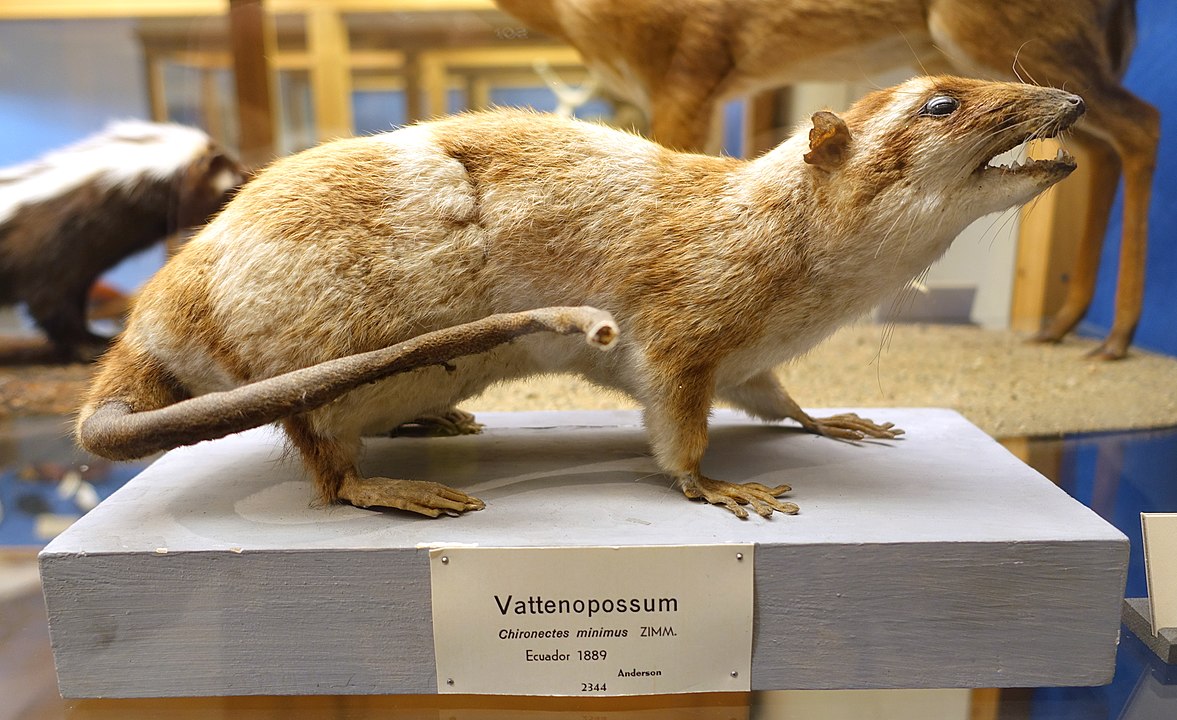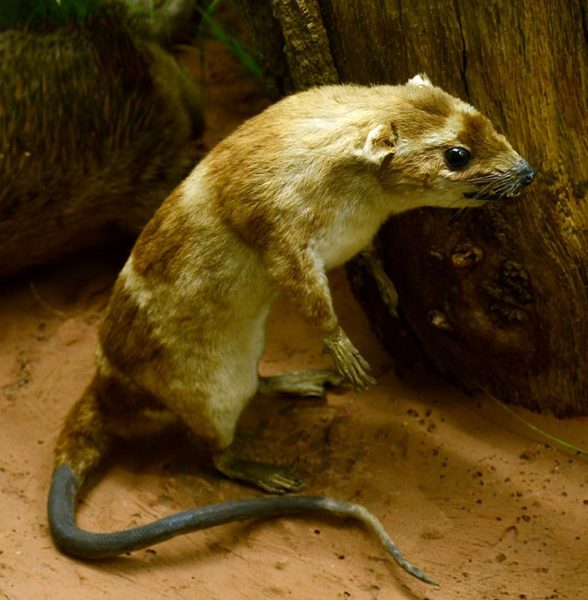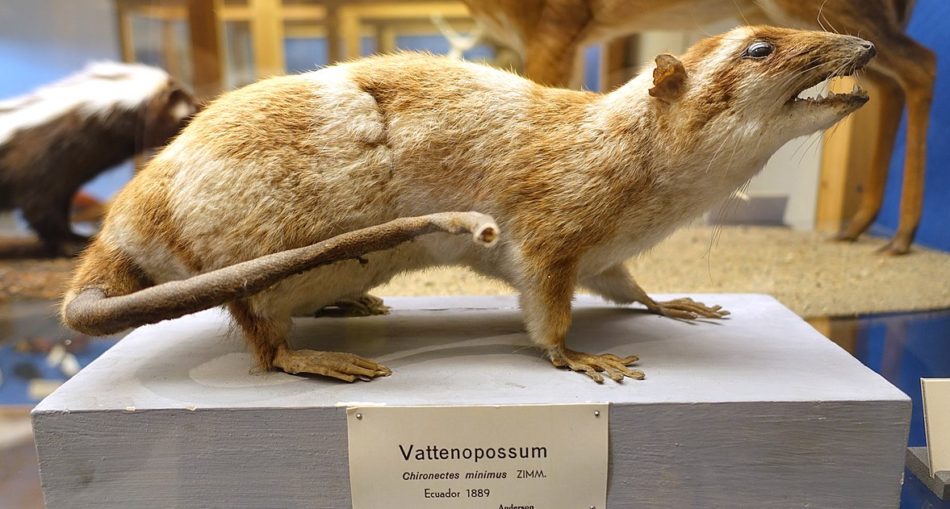The Water Opossum is very similar to the Common Opposum however a key difference to note is that the Water Opossum prefers aquatics habitats. Its hind legs are webbed and well-adapted for swimming as the creature spends most of its life by the water. Water Opossums are mostly active during the night and rest during the day in a nest built not far away from their den. This marsupial is intriguingly waterproof and tends to eat a lot of prey which produces a lot of oil to maintain its shiny coat of fur.
The scientific name for the Water Opossum is Chironectes minimus it is called the yapok. The name ‘yapok’ is most likely derived from the Oyapok River in French Guiana, an area where it is native to. In addition to French Guiana the Water Opossum or yapok is native to Mexico, parts of Central and South America in countries like Colombia, Ecuador, Peru, Venezuela, Guyana, Suriname, French Guiana, Brazil, Paraguay and Argentina.

Water Opossum – Photo by: By Daderot – Own work, CC0, https://commons.wikimedia.org/w/index.php?curid=42027562
Features Of The Water Opossum
- Sexual Dimorphism – Sexual dimorphism is present in the Water Opossum for the males are generally larger than their female counterparts.
- Overall Body – Water Opossums are very small marsupial with long, skinny tails. In some cases, tails are longer than their bodies. They use their tails as a rudder when swimming or to carry objects. Its pointed ears are naked. Their facial bristles and whiskers, located under the eye help them to find predators and potential prey while in the water.
- Colour – The Water Opossum can be distinguished by a white strip above its eyes and another beneath its lower jaw. The rest of its fur is grey and black, but the muzzle, crown and eyestripe are completely black. The tail is black at its base but ends in either yellow or white.
- Paws – While the Water Opossum has webbed hindfeet, the forefeet which are used to forage as the animal swims, are not webbed.
- Snout – Snouts are relatively short and ending in a black muzzle.
- Limbs – Water Opossums have four limbs and are able to swim.
- Weight & Length – The Water Opossum ranges in size from twenty-seven to forty (27-40) cm long weighing between six hundred four to seven hundred ninety (604-790) g.

Water Opossum aka Yapok – Photo By Vassil – Own work, CC0, https://commons.wikimedia.org/w/index.php?curid=46557632
Scientific Classification Of The Water Opossum
Water Opposum – Chironectes minimus [Scientific name]
- Kingdom: Animalia
- Phylum: Chordata
- Class: Mammalia
- Infraclass: Marsupialia
- Order: Didelphimorphia
- Family: Didelphidae
- Subfamily: Didelphinae
- Tribe: Didelphini
- Genus: Chironectes
Illiger, 1811 - Species: C. minimus
Habitat Of The Water Opossum
The Water Opossum is typically found in tropical, and subtropical habitats. They seem to prefer semi-aquatic or aquatic places like freshwater streams and lakes close to the shore of these tropical, subtropical habitats. Their range of habitat is anywhere from zero to one thousand eight hundred and sixty (0-1860) m above sea level. Water Opossums live in dens built above the water level in banks or in moderate or clear areas or tropical forest. They tend to build their large burrows between the roots of trees. Water Opossums also build diurnal nests of collected leaves and grasses where they rest during the day.
Interesting Tip
- These creatures avoid defecating close to their nest because it may attract predators.
Diet Of The Water Opossum
The yapok or Water Opossum is prone to foraging near waterways, like rivers and stream. Their diet includes crustaceans, frogs, fish, aquatic insects, plants and fruits when there is limited food sources.
Reproduction Of The Water Opossum
The breeding season of the Water Opossum varies by their range. For example in Brazil, the breeding season lasts from December to February while in Venezuela, breeding is in January, November and July whereas, in Argentina, it is in August. Females are able to breed up to three (3) times per breeding season. During the pre-copulatory period, the male and female form firm social bonds. A typical litter would have about three to four (3-4) offspring. After birth, the young climb into the pouch of the mother to nurse. Their eyes open within thirty-eight (38) days and they also develop pigmentation of fur. Around the time they begin seeing, they are too large to stay in their mother’s pouch but they still nurse. After forty-five to sixty (45-60) days, the young become independent yet remains close to its mother.
4 Facts About The Water Opossum
- The Water Opossum is hostile during feeding, even been seen sitting on its forelegs, aggressively tearing into food.
- Because it lives near rivers, stream and lakes the mammal’s diet is primarily made up for aquatic plants and animals.
- During diving, its pouch will close naturally.
- Males will defensively circle a female who is carrying offspring.
- Unlike other opossums instead of using its tail to climb, the Water Opossum uses its tail to swim.
The Water Opossum in Guyana
The Water Opossum or yapok is one of the opossums native to Guyana. However, its habits are quite contradicting to the norm. Instead of frequenting the tree, the Water Opossum lives on the ground, near to waterways using its tail as a rudder. It’s an aquatic mammal who forages in water for fish or plants if the former is unavailable. Its legs help it to paddle in the water while its forelegs are used to snatch the unsuspecting prey. Water Opossums are generally smaller than a common opossum so you’ll be sure to spot the difference!
Article References
- https://animaldiversity.org/accounts/Chironectes_minimus/
- https://en.wikipedia.org/wiki/Water_opossum
- https://www.kaieteurnewsonline.com/2012/12/02/the-water-opossum-chironectes-minimus/#:~:text=The%20name%20for%20the%20water,pouch%20that%20closes%20during%20dives.
- http://www.faunaparaguay.com/mamm4Chironectesminimus.pdf







